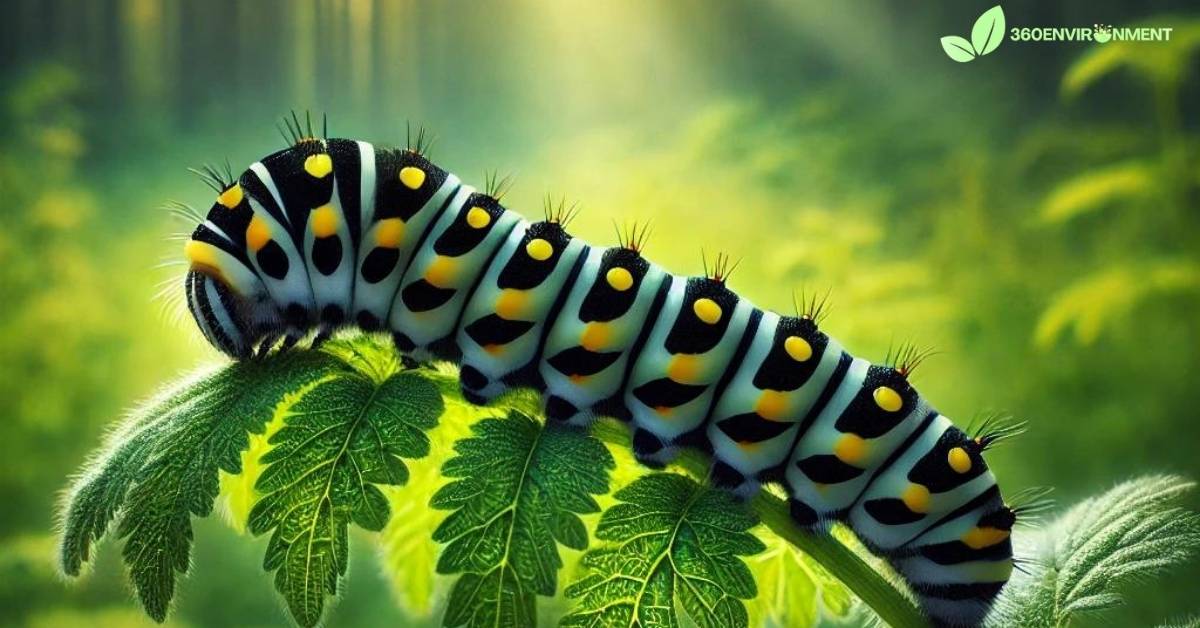The black and yellow caterpillar is a fascinating and visually striking insect that plays a vital role in various ecosystems. While the term “black and yellow caterpillar” can refer to numerous species with distinctive coloration, this pattern is often associated with warning signals, camouflage, and other adaptive behaviors that caterpillars use to survive. These caterpillars represent the larval stage of moths and butterflies, undergoing metamorphosis before emerging as adults, and they contribute significantly to ecological processes such as herbivory, predation, and nutrient cycling.
In this article, we will explore the environmental niche of the black and yellow caterpillar, examining its habitat preferences, feeding behavior, interactions with predators and other species, and the importance of conserving their populations. Understanding the unique adaptations and roles of these caterpillars sheds light on the broader ecological functions they fulfill in maintaining the health of ecosystems.
1. Habitat and Geographic Distribution of Black and Yellow Caterpillars
Black and yellow caterpillars can be found in a wide range of habitats around the world, from temperate forests and meadows to tropical rainforests and grasslands. Their ability to adapt to diverse environments is one of the reasons for their success as a group, and their distinctive coloration helps them either avoid predators or blend into their surroundings.
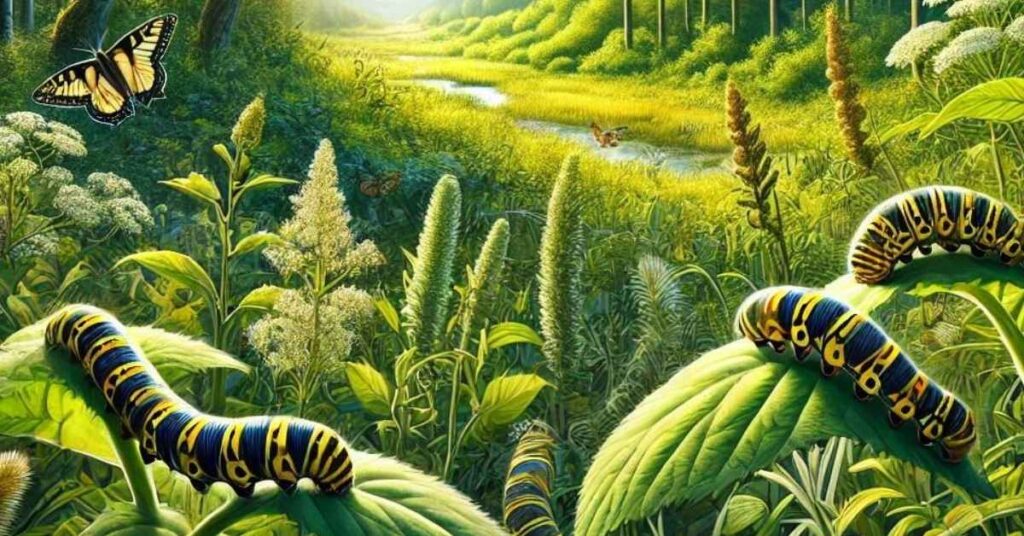
1.1. Temperate Forests and Woodlands
Many species of black and yellow caterpillars thrive in temperate forests and woodlands, where the abundance of vegetation provides a rich source of food and shelter. These habitats often feature dense tree canopies, undergrowth, and leaf litter, offering caterpillars protection from predators and harsh weather conditions.
- Monarch Caterpillar (Danaus plexippus): The iconic black, white, and yellow-striped monarch caterpillar is one of the most recognizable caterpillars in North America. It primarily inhabits temperate forests, meadows, and fields where milkweed plants, the sole food source for monarch larvae, grow in abundance.
- Cinnabar Moth Caterpillar (Tyria jacobaeae): Another well-known black and yellow caterpillar is the cinnabar moth caterpillar, found across Europe and introduced to North America and Australia. It feeds on ragwort, a common plant in open woodlands, meadows, and grasslands.
1.2. Grasslands and Meadows
Grasslands and meadows are ideal habitats for many black and yellow caterpillars, providing a variety of plant species on which to feed. These open environments allow caterpillars to move freely between different plant hosts while benefiting from the abundant sunlight and warmth that accelerates their development.
- Spicebush Swallowtail Caterpillar (Papilio troilus): This caterpillar is known for its striking black and yellow coloration in its early stages. It primarily inhabits grassy fields, meadows, and open woodlands in the eastern United States, where it feeds on spicebush and sassafras plants.
- Eastern Tent Caterpillar (Malacosoma americanum): Found throughout North America, this caterpillar is commonly seen in grassy areas, along roadsides, and in open forests. Although it has a different color pattern as it matures, the early instar stages often display black and yellow markings, making it highly visible to both predators and humans.
1.3. Tropical Rainforests and Subtropical Regions
Tropical and subtropical regions host a variety of black and yellow caterpillars that have adapted to the warm, humid climates and dense vegetation. The rich biodiversity of rainforests provides caterpillars with access to numerous host plants, as well as the shelter needed to avoid predators and complete their life cycle.
- Hawk Moth Caterpillars (Sphingidae family): Many species within the Sphingidae family, also known as hawk moths, feature caterpillars with black and yellow patterns. These caterpillars are found in tropical rainforests and subtropical habitats, where they feed on a wide variety of host plants, including vines, shrubs, and trees.
- Zebra Swallowtail Caterpillar (Eurytides marcellus): Native to the southeastern United States, this caterpillar has distinctive black and yellow stripes, helping it blend into its environment. It is commonly found in moist, subtropical forests and wetlands, feeding on pawpaw plants.
1.4. Urban and Suburban Areas
As human populations expand, many caterpillar species have adapted to urban and suburban environments. Gardens, parks, and even roadside areas can serve as habitats for black and yellow caterpillars, particularly those that rely on common garden plants or invasive species.
- Tomato Hornworm (Manduca quinquemaculata): This large caterpillar is known for its green body with black and yellow markings, making it a common pest in suburban gardens. It feeds on tomato, pepper, and potato plants, which are often grown in both residential and commercial agricultural areas.
- Milkweed Tussock Caterpillar (Euchaetes egle): Often found in urban gardens and parks where milkweed plants are grown, this fuzzy black, yellow, and white caterpillar is common in North America. It prefers milkweed as its host plant, similar to the monarch caterpillar.
2. Adaptations of Black and Yellow Caterpillars
The black and yellow coloration of these caterpillars serves as more than just a striking visual characteristic. It represents a range of adaptive strategies that caterpillars use to survive in environments filled with predators, parasites, and other environmental pressures.
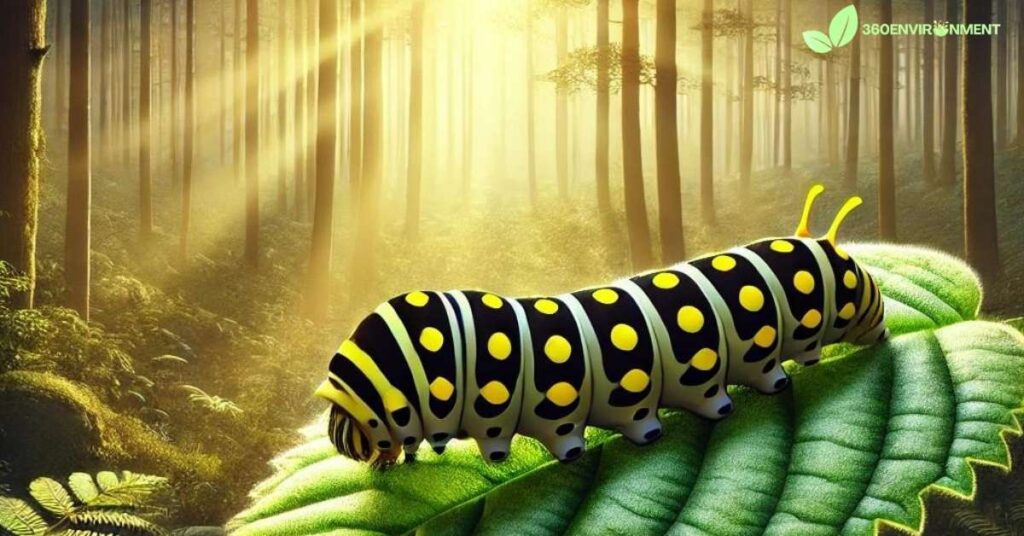
2.1. Warning Coloration (Aposematism)
One of the most common adaptations associated with black and yellow caterpillars is aposematism, a warning signal to potential predators that the caterpillar is toxic or unpalatable. Many species have evolved bright colors as a defense mechanism to deter predators such as birds, reptiles, and small mammals.
- Monarch Caterpillar: The monarch caterpillar’s black, yellow, and white stripes serve as a clear warning to predators. The caterpillar feeds on milkweed, which contains toxic compounds known as cardiac glycosides. These toxins accumulate in the caterpillar’s body, making it poisonous to most predators.
- Cinnabar Moth Caterpillar: Similarly, the black and yellow cinnabar moth caterpillar feeds on the toxic leaves of the ragwort plant. The bright coloration warns predators that it is toxic and should not be eaten. Birds, in particular, learn to avoid caterpillars with this color pattern after an unpleasant experience.
2.2. Camouflage and Mimicry
Not all black and yellow caterpillars rely on toxicity for protection. Some species use their coloration for camouflage or mimicry, blending into their environment or imitating more dangerous insects, such as bees or wasps, to avoid predation.
- Spicebush Swallowtail Caterpillar: In its early instar stages, the spicebush swallowtail caterpillar is black with yellow spots, mimicking bird droppings to avoid detection by predators. As the caterpillar matures, it transforms into a bright green color with large eyespots, mimicking a snake to further deter predators.
- Hawk Moth Caterpillars: Many hawk moth caterpillars are experts in mimicry, using their black and yellow coloration to resemble venomous snakes or other dangerous animals. Some species even have false eyespots on their bodies, which give them the appearance of a larger, more threatening creature.
2.3. Physical Defenses and Behavioral Strategies
In addition to their coloration, black and yellow caterpillars have evolved other physical and behavioral defenses to protect themselves from predators. These include bristles, spines, and the ability to drop from plants when threatened.
- Milkweed Tussock Caterpillar: This caterpillar is covered in tufts of black, yellow, and white hair, which make it appear larger and more intimidating to predators. The hairs can also be irritating to the skin of potential predators, discouraging them from attempting to eat the caterpillar.
- Eastern Tent Caterpillar: Eastern tent caterpillars exhibit group behavior as a form of protection. They build communal silk tents in the branches of trees, where they remain hidden from predators during the day. At night, they emerge in groups to feed, reducing the chances of individual caterpillars being targeted.
3. Ecological Role of Black and Yellow Caterpillars
Black and yellow caterpillars play an important role in the ecosystems they inhabit. As herbivores, they contribute to plant population control and nutrient cycling, while also serving as a critical food source for many predators. Their presence and activities help shape the dynamics of the ecosystems they belong to.
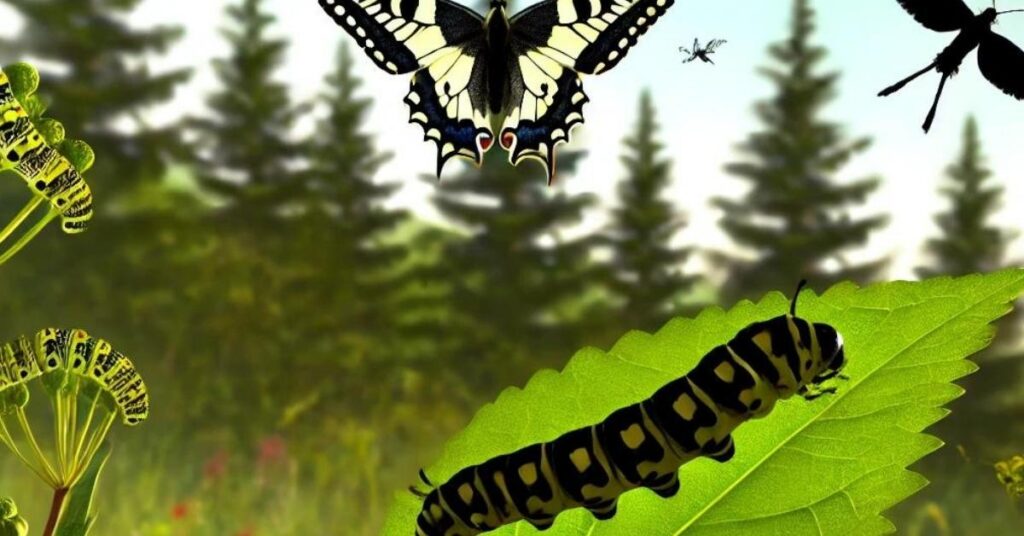
3.1. Herbivory and Plant Population Control
Caterpillars are voracious herbivores, feeding on the leaves of plants, shrubs, and trees. By doing so, they help regulate plant populations and prevent any single species from dominating the ecosystem.
- Monarch Caterpillars and Milkweed: Monarch caterpillars feed exclusively on milkweed, helping to control the growth of these plants. While milkweed is toxic to many animals, monarch caterpillars have evolved to tolerate the plant’s toxins, allowing them to thrive in environments where other herbivores cannot.
- Cinnabar Moth Caterpillars and Ragwort: Cinnabar moth caterpillars play a similar role in controlling ragwort populations. Ragwort is considered an invasive species in some regions, and the caterpillars help reduce its spread by feeding on its leaves. In areas where cinnabar moths are introduced for biological control, they help manage ragwort infestations without the need for chemical pesticides.
3.2. Role in Nutrient Cycling
As caterpillars feed on plant material, they contribute to nutrient cycling within ecosystems. By breaking down leaves and other plant matter, caterpillars help release nutrients back into the soil, where they can be used by other plants.
- Decomposition and Soil Health: When caterpillars die or are consumed by predators, their bodies decompose, returning essential nutrients to the soil. This process is particularly important in forest and grassland ecosystems, where nutrient recycling supports the growth of new plants.
- Leaf Litter Contribution: Caterpillars that feed on tree leaves often contribute to the production of leaf litter, which accumulates on the forest floor. This leaf litter provides habitat for microorganisms and invertebrates, further enhancing soil fertility and ecosystem health.
3.3. Prey for Predators and Parasitoids
Black and yellow caterpillars are an important food source for a wide variety of predators, including birds, mammals, reptiles, and other insects. Their role as prey is essential for maintaining the balance of food webs in the ecosystems they inhabit.
- Bird Predators: Many bird species, including warblers, flycatchers, and chickadees, rely on caterpillars as a primary food source, particularly during the breeding season when they need extra protein to feed their chicks. While some caterpillars are toxic, many are consumed by birds, contributing to the overall energy flow in the ecosystem.
- Parasitoid Wasps: In addition to being prey for larger animals, caterpillars are often targeted by parasitoid wasps. These wasps lay their eggs inside the caterpillar’s body, and when the eggs hatch, the larvae consume the caterpillar from the inside. While this may seem gruesome, parasitoid wasps play an important role in regulating caterpillar populations and preventing outbreaks of herbivory that could damage plant communities.
4. Conservation of Black and Yellow Caterpillars
Despite their ecological importance, black and yellow caterpillars face numerous threats that can impact their populations and the ecosystems they support. Habitat loss, pesticide use, and climate change all contribute to the decline of caterpillar populations, making conservation efforts essential for their survival.
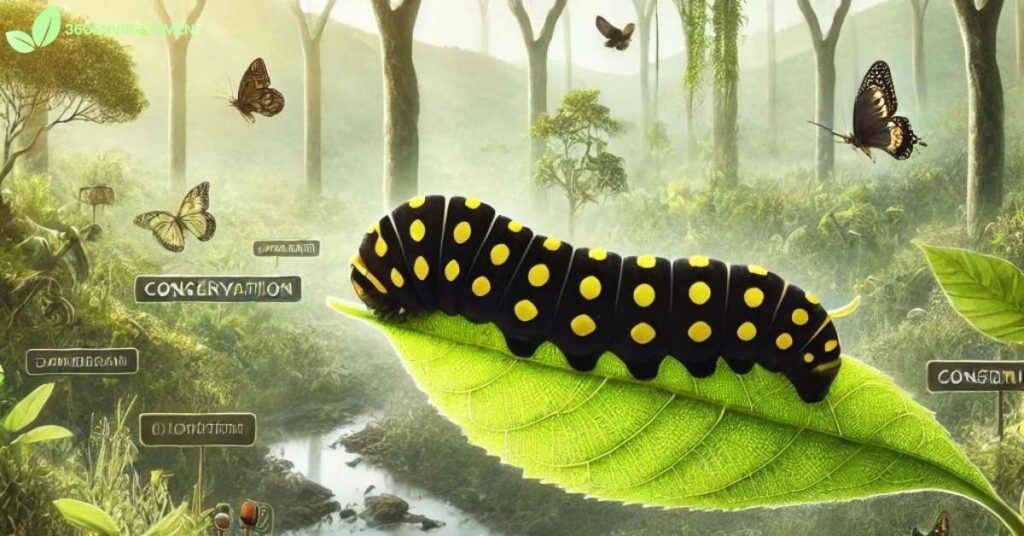
4.1. Habitat Loss and Fragmentation
One of the greatest threats to black and yellow caterpillars is the loss and fragmentation of their natural habitats. As forests, grasslands, and wetlands are converted into agricultural land, urban developments, and infrastructure projects, caterpillars lose access to the host plants they need to survive.
- Urbanization and Development: The expansion of cities and suburbs leads to the destruction of natural habitats, reducing the availability of food and shelter for caterpillars. In many areas, the loss of native plants and the introduction of non-native ornamental species further limit the resources available to caterpillars.
- Agricultural Practices: Large-scale agriculture often involves the removal of native vegetation and the use of monoculture crops, which reduce the diversity of host plants that caterpillars rely on. In addition, agricultural landscapes are often treated with pesticides and herbicides, which can be harmful to caterpillar populations.
4.2. Pesticide Use and Chemical Pollution
The widespread use of pesticides in agriculture and landscaping is one of the most significant threats to caterpillars and other insects. Pesticides can kill caterpillars directly, as well as reduce the availability of food by killing the plants they rely on.
- Impact of Neonicotinoids: Neonicotinoid pesticides are particularly harmful to caterpillars and other pollinators, as they affect the central nervous system of insects. Exposure to neonicotinoids can impair caterpillars’ ability to feed, grow, and complete their development, leading to population declines.
- Herbicides and Host Plants: The use of herbicides to control weeds can also have unintended consequences for caterpillars. Many species of caterpillars rely on native “weeds” such as milkweed, ragwort, and nettles as host plants. When these plants are removed, caterpillars lose their primary food source, leading to reduced survival rates.
4.3. Climate Change and Its Effects on Caterpillar Populations
Climate change is expected to have wide-ranging impacts on caterpillar species, including black and yellow caterpillars. Changes in temperature, precipitation patterns, and the timing of plant blooming could disrupt the life cycles of these insects, making it more difficult for them to survive and reproduce.
- Phenological Mismatches: Climate change could cause phenological mismatches, where the timing of caterpillar emergence no longer aligns with the availability of host plants. This could result in reduced survival rates for caterpillars and could also impact the species that rely on them as a food source.
- Range Shifts: As temperatures rise, some species of caterpillars may be forced to shift their ranges to cooler, higher elevations or latitudes. This could lead to the loss of populations in certain areas while new populations establish themselves in previously unsuitable habitats.
5. Promoting the Conservation of Black and Yellow Caterpillars
Conserving black and yellow caterpillars requires a multi-faceted approach that addresses habitat preservation, reducing pesticide use, and raising public awareness about the importance of these insects in ecosystems. By protecting their habitats and reducing the threats they face, we can help ensure the survival of these ecologically significant creatures.
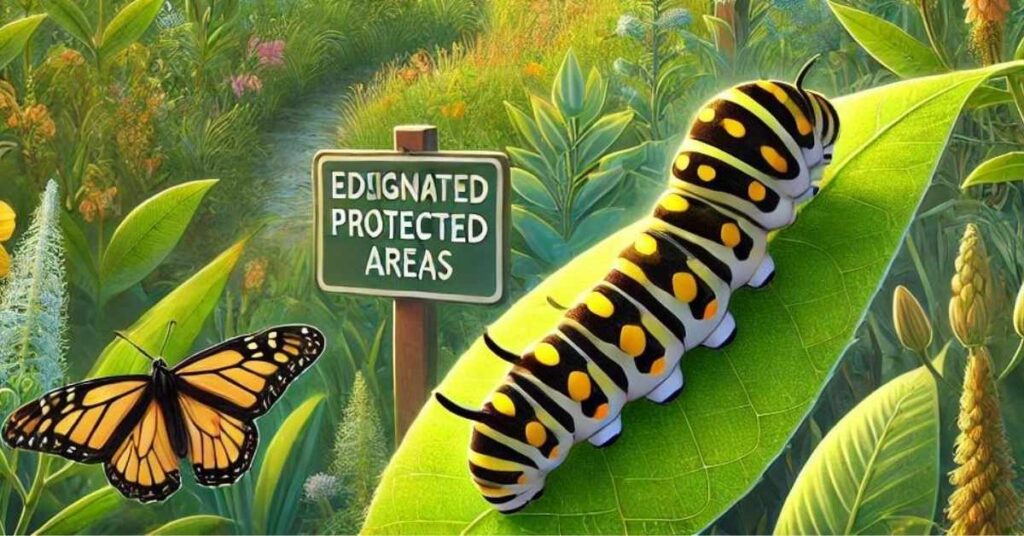
5.1. Habitat Preservation and Restoration
One of the most effective ways to conserve black and yellow caterpillars is to protect and restore their natural habitats. This can involve preserving forests, grasslands, and wetlands, as well as creating pollinator-friendly gardens in urban and suburban areas.
- Native Plant Gardens: Homeowners and gardeners can support caterpillar populations by planting native plants that serve as host plants for caterpillars. For example, planting milkweed in gardens and parks can help support monarch caterpillars, while ragwort and other native species can provide food for cinnabar moth caterpillars.
- Forest and Grassland Conservation: Protecting large areas of forest and grassland from development is essential for maintaining healthy caterpillar populations. Conservation efforts should focus on preserving habitat corridors that allow caterpillars to move between different areas and find food, shelter, and mates.
5.2. Reducing Pesticide Use
Limiting the use of harmful pesticides is essential for protecting caterpillars and other pollinators. By adopting more sustainable farming and gardening practices, we can reduce the negative impacts of chemical use on insect populations.
- Organic Farming Practices: Organic farming practices, which avoid the use of synthetic pesticides and fertilizers, can help create a healthier environment for caterpillars and other pollinators. Organic farms tend to have higher biodiversity, providing caterpillars with more food sources and nesting opportunities.
- Integrated Pest Management (IPM): Farmers and gardeners can use IPM strategies to reduce their reliance on chemical pesticides. IPM practices include monitoring pest populations, using biological controls, and applying pesticides only when absolutely necessary.
5.3. Public Awareness and Education
Raising public awareness about the importance of caterpillars in ecosystems is essential for promoting conservation efforts. Education campaigns can encourage people to take action to protect caterpillars and their habitats.
- Citizen Science and Monitoring: Engaging the public in citizen science projects that monitor caterpillar populations can provide valuable data for conservation efforts. By reporting sightings of caterpillars and their behavior, citizens can contribute to a better understanding of caterpillar ecology and the challenges they face.
- Educational Programs: Schools, nature centers, and conservation organizations can offer educational programs that teach people about the ecological role of caterpillars and the importance of conserving their habitats.
Conclusion: The Ecological Importance of Black and Yellow Caterpillars
Black and yellow caterpillars are more than just visually striking insects. They play a crucial role in herbivory, plant population control, nutrient cycling, and the food web. Their adaptations, including warning coloration and mimicry, help them survive in a world filled with predators, while their feeding behaviors contribute to the health and balance of ecosystems.
However, black and yellow caterpillars face significant threats from habitat loss, pesticide use, and climate change. By understanding the environmental niche of these caterpillars and taking action to protect their habitats, we can help ensure the survival of these important insects and the ecosystems they support. Whether through habitat restoration, reducing pesticide use, or public education, we can all play a role in conserving black and yellow caterpillars and promoting biodiversity in our natural world.
Read More: The Environmental Niche of Orange Butterflies: Exploring Their Ecological Roles, Adaptations, and Conservation

